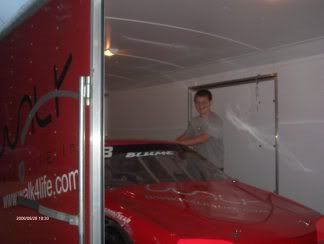Jean-Phillipe Speder and Jean-Louis Seel met for the first time when they were in high school in 1978. They were both natives of Belgium and had grown up hearing about WWII and particularly about the Battle of the Bulge which was largely fought in the area they called home.
For several years much of this area was closed to visitors of any kind because of the abundance of explosives left over from the war. Many explosive devices are still found there. A determined effort was made to clean up these explosives and in doing so some marked and unmarked graves were found in the cleared areas by policemen and forensic teams. However, many of the heavily forest areas were not searched for remains.
In the mid-1970s the two young men began to search for artifacts and souvenirs, which were plentiful. On a rainy day in February 1980 they went searching with JP's new mine detector. JL found his first dog tag before he was 18 years old near Rocherath. It had belonged to Max Wisnieski from Waukesha WI, who had been a member of A Company, 385th Infantry Regiment, 2nd Division. With Will Cavanagh's help, Wisnieski's widow was located and the dog tag returned to her.
This opened up a completely new vista — real front line soldiers with real stories. They now began searching for items with personal identification such as dog tags, ID bracelets, mess kits and canteens with names and serial numbers or laundry numbers scratched in them. (Army laundry markers were the first letter of the soldier's last name followed by the last four digits of his serial number.) In 1986 they contacted the 99th Infantry Division Association for help in identifying and locating men to match the numbers they were gathering. This began a close association and in 1987 JP and JL joined the 99th Association.
Over the years they have been able to identify items belonging to more than 450 veterans from more than 50 different units and, in most cases, returning them to the veteran or his family. They have built an extensive file of names, serial numbers and units. In some cases it has been harder to find the veteran than it was to find the artifact. Veterans of the 99th welcomed these men as members and called them "The Diggers."
From the Rockford Register Star, June 23, 2002
ROCHELLE — Jean-Louis Seel had always thought of Stanley E. Larson, and the other American soldiers whose remains he had recovered, as a soldier.
But at Rochelle United Methodist Church, as a young boy rounded a corner, Seel made the connection: Stanley the young boy. Stanley the teenager.
Here was his hometown, his past. Stanley, the high school basketball star. The fresh-faced boy who had a kind word for everyone. The young gentleman in glasses whose keen personality and confident smarts had made him student council president his senior year.
Monday was a day of strange contrasts for the Larson family, who laid to rest one of its oldest members, who was also one of the youngest: Pfc. Stanley E. “Mike” Larson, struck down by enemy fire at the age of 19 in a war that most of the people at his funeral were much too young to have seen.
After being buried in a common grave for 57 years not far from where he fell on Dec. 16, 1944, during the Battle of the Bulge, Larson’s remains were discovered last summer deep in the Monschau Forest by a group of Belgian “diggers” — four men, including Seel, who have taken on the recovery of American MIAs as a personal mission.
They had traveled from another hemisphere to see Stanley come back to his hometown, a Midwestern crossroads ringed by tassle-headed cornfields and shingled red barns.
And now they stood in the oppressive summer heat to say farewell to a young man killed on a historic, bitter winter’s day. About 200 people gathered alongside them at Stanley’s gravesite, including the great-grandnieces and great-grandnephews he never knew but who, today, tenderly walked to his silver casket and left a handful of red poppies.
Stanley’s father, Elmer, had bought that plot for his youngest son nearly half a century ago. Now 16 members of VFW posts from throughout northern Illinois saluted their fallen comrade with a color guard. Seven white-gloved men and women sent by the U.S. Army from Fort Leonard Wood in Missouri raised their rifles and sounded the crack of three volleys for one of America’s 58,000 World War II MIAs who had finally come home.
And as a bugler played taps, a train whistle in the distance blew in an uncanny, solemn harmony.
“These people are here today to give the family final closure,” said Kenneth Seay of Loves Park VFW Post 9759. Seay, the POW/MIA director for the state, held the POW/MIA flag in the formal color guard at the gravesite. On his wrist he wears a thick band engraved with the names of the 98 Vietnam POW/MIAs from Illinois.
“With everything that’s gone on in the past year, we really need to pay respect to those who’ve gone before,” said Sen. Brad Burzynski, R-Clare, who attended the funeral.
“I believe God was with Stanley and his buddies when that barrage of hot steel came down upon them,” said the Rev. Brian Channel, a military history buff who gave the sermon during the church funeral preceding Stanley’s burial with military honors.
“Stanley’s journey ends today after half a century.”
The casket lay in the church draped with a U.S. flag — just as it had at a similar ceremony months ago in a village church near where Stanley’s body was found. Close to 2,000 people, many of them Belgians wanting to show gratitude to the American troops who helped secure their liberty, attended that day.
On Monday, the flag of Belgium, with its bold vertical stripes in black, gold and red, flanked the altar along with the Stars and Stripes. Belgian “digger” Jean Philippe Speder told the congregation how, when he was a teenager, he’d heard his grandparents talk about the war. But later he realized that those memories were dimming among his peers.
“The picture of the GI was fading as a new generation, including mine, grew up,” he said.
Speder painted the woods where Stanley lay for 57 years as a place of “serene and magnificent deep forest, known for its high marshes and spring waters.”
More MIAs lie in unknown pockets of those woods. “Those boys will always be home,” he said, “and will live in our hearts forever.”
The friends and family who spoke at the funeral unraveled the compelling tale of how Stanley was searched for and found. In few words, Battle of the Bulge veteran Roger Foehringer reminded all why they had come: “He’s the real hero. He gave his life, his life for us.”
“Home is where I belong,” Foehringer said, speaking for Stanley, “Goodbye, friends.”

Stan Larson joined the Army during WWII in the hopes that if he went, his brother Leon, in the Navy, would be able to come home. Leon did indeed get to come home, raise a family and take over the family business, but not until after the war. Stanley, on the other hand, had to wait over 57 years to make it back, thanks to the dedication of the Belgian Diggers. It was only about a year after Stan's return that Leon died. I really think he held on all that time until he knew his brother was home.













